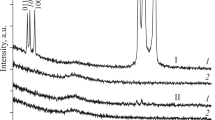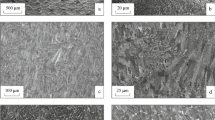Abstract
Aluminum alloys in a rapidly quenched state are studied by four technological methods, namely, fabricating foils and wire with unique properties, fabricating granulated alloys, surface strengthening and alloying articles by a laser or an electron beam treatment, and realizing superplasticity. In rapid quenching of alloys, crystallization occurs with cooling the melt at a rate of at least 103–104 K/sec. Such cooling can be realized in practice by several methods, for example, by drop crystallization on a rotating heat-conducting substrate, spraying of the melt in a cooling medium, quenching a thin foil on cooled rolls in liquid rolling, or melting a thin surface zone of a quite massive part. The present paper describes a study of flakes of aluminum alloys obtained by the method of drop crystallization.
Similar content being viewed by others
References
V. I. Dobatkin and V. I. Elagin,Granulated Aluminum Alloys [in Russian], Metallurgiya, Moscow (1981).
I. S. Miroshnichenko,Liquid Quenching [in Russian], Metallurgiya, Moscow (1982).
K. V. Chuistov,Aging of Metallic Alloys [in Russian], Naukova Dumka, Kiev (1985).
P. A. Parkhutik and M. Z. Lubenskii, “Effect of the crystallization conditions on the structure of aluminum-silicon alloys,”Metalloved. Term. Obrab. Met., No. 9, 68–69 (1972).
S. C. Agarwal, and H. Herman, “Early-stage phase separation in liquid-quenched Al−7 at.% Zn,”J. Mater Sci.,13(7) 1549–1554 (1978).
S. C. Agarwal, M. J. Koczak, and H. Herman, “Precipitation of liquid-quenched Al-base alloys,”, No. 8, 401–408 (1977).
A. M. Bastawros, H. M. El. Labany, and M. Z. Said, “Study of melt spun Al−Cu ribbons on aging,”Indian J. Pure Appl. Phys.,82(7), 503–509 (1991).
I. N. Fridlyander,Aluminum Deformable Structural Alloys [in Russian], Metallurgiya, Moscow (1979).
B. A. Kolachev, V. A. Livanov, and V. I. Elagin,Physical Metallurgy and Heat Treatment of Metals and Alloys [in Russian], Metallurgiya, Moscow (1981).
V. S. Muratov, “Formation of a rapidly quenched surface layer and fatigue endurance of aluminum alloys,”, in:The Physics of Strength and Ductility of Metals and Alloys, Abs. Rep. XIII-th Int. Conf. [in Russian], Samara (1992).
Author information
Authors and Affiliations
Additional information
Translated from Metallovedenie i Termicheskaya Obrabotka Metallov, No. 5, pp. 31–34, May, 1997.
Rights and permissions
About this article
Cite this article
Muratov, V.S. Structure formation and properties of rapidly quenched aluminum alloys. Met Sci Heat Treat 39, 214–218 (1997). https://doi.org/10.1007/BF02467288
Issue Date:
DOI: https://doi.org/10.1007/BF02467288




